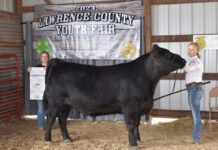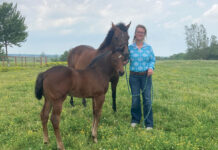
Alex Magee says great cattle and great people made this breed the right choice for his ranch
PORTER, OKLA. – Alex Magee along with his wife Brittania and kids own an 80-acre ranch, Oklahoma Beefmasters, located in Porter, Ok. in rural Wagoner County.
You could almost say Alex Magee was raised to be a Beefmaster cattleman. From an early age in Northeast Oklahoma, he has spent much of his time around the hardy breed of cattle.
“When I was younger, my grandparents were in the dairy industry and bought some commercial beef cattle and they happened to be Beefmasters,” Magee said. “My uncle was raising Blonde d’Aquitaine cattle at that time, and we were putting those bulls over on those commercial Beefmaster females and they were doing really good and a lot of thickness and a lot of weight to those calves and stuff. I guess they kind of piqued my uncle’s interest there. He went and looked at some purebred cattle and he bought a handful of them, I think maybe a dozen or so, and put them over in a pasture separate from his Blonde d”Aquitaine stuff that he was raising. He started noticing that they were a lot more efficient cattle than the Blonde cattle were.”
As his uncle got more and more involved with the Beefmaster breed, Magee was watching and taking mental notes. Even as a teenager he could see differences that stuck out to him.

“They didn’t take as much to feed them and keep them in body condition,” Magee said. “And the calves were weaning off bigger, bigger than the blondes, even though the blonde cows were a lot bigger cows. I kind of got a cow or two from him and started enjoying the Beefmaster side of things. By the time I was a teenager, I had started traveling around to the sales with him and seeing the different stuff.”
By the time Magee had graduated from high school and college and had gotten a job at the OSU Extension Services, he was ready to put his knowledge to the test on his own ranch. He started out with three cows and two heifers and slowly built his ranch in what is today known as, Oklahoma Beefmaster.
Magee said he keeps the size of the herd to around 35 pairs. “I can’t really handle more unless I can find some more rent pasture,” Magee said. “So, I pretty well got to have a fairly high cull rate. I’m kind of maxed out really. I have a few too many for this place, but it’ll handle it with a little bit of fertilizing and spraying that kind of deal.”
Magee said he did look at other breed options when he started his ranch. But he just couldn’t get past how well the Beefmaster fit what he was looking for in cattle.
“They’re really good females. They’re real efficient cows as far as staying in good body condition and raising big calves,” Magee said. “And they’re just very efficient and they can kind of handle a wide variety of environments. They’re down in south Texas and I’ve got friends that live in Minnesota and they raise them there too. And they do just as well there as the rest of the cattle up there.”

Because of their ability to adapt to a variety of environments, Magee has sold bulls in Nevada, Florida, Georgia, Arkansas, Texas, Missouri, Minnesota, and of course Oklahoma.
“They always thrive and do well. They’re just a hardy animal and they’re super gentle for the most part,” Magee said. “And just a good kind of cow to have around. I don’t have as many problems with them as some other breeds. You really don’t.”
Yet, while Magee may be kind of biased when it comes to what he thinks about the Beefmaster, his customers are the true barometer. Especially the ones who come back to Oklahoma Beefmaster year after year at the Beef on Forage sale.
“I’m part of a group called Beef on Forage, and we have sales where a lot of the bulls go to Florida and Nevada and other places as well that they sell to,” Magee said. “We’ll start with about 380 bulls between a whole bunch of us, and they’ll cull it down to about probably 240 that sell every fall. And then in the spring they’ll usually be 180 bulls and they’ll cull down to about 100 bulls for the spring sale. I make sure they got good udders and feet. It doesn’t matter how good they look if they have bad feet or bad udders. And we’ve got to be functional for sure. I don’t know if I’d do anything special, just feed them well. I try not to feed them stuff where they’re not going to fall apart when they go somewhere. And for the most part, that’s held pretty true.”
Magee is still pretty early into his career and is looking to keep growing the business.
“I’d like to come up with a little more land and grow numbers-wise a little more and just kind of keep going down the path I’m going with the organizations I’m trying to be a part of,” Magee said.







